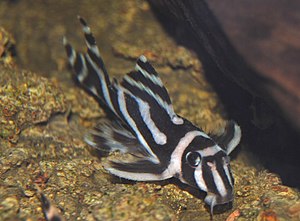Zebra catfish
| Zebra catfish | ||||||||||||
|---|---|---|---|---|---|---|---|---|---|---|---|---|

Zebra catfish ( Hypancistrus zebra ) |
||||||||||||
| Systematics | ||||||||||||
|
||||||||||||
| Scientific name | ||||||||||||
| Hypancistrus zebra | ||||||||||||
| Isbrücker & Nijssen , 1991 |
The Zebra Wels ( Hypancistrus zebra ) is a swimming toy fish of the genus Hypancistrus . It was first discovered in the late 1980s in the Rio Xingú in Brazil .
Since the beginning of 2005 the Brazilian government has banned the trapping, breeding and export of the zebra fish because the stocks in the Rio Xingú are very endangered. The planned construction of the Belo Monte hydropower plant would dry out the entire habitat of the zebra fish.
This fish can reach an age of approx. 15 years and a size of approx. 8-10 cm, males over ten years can reach approx. 12 cm.
The gender differences are very difficult and only detectable after two or three years of life. The male usually has a wider head and therefore looks a bit more massive. Furthermore, the skin teeth ( odontodes ) on the gill covers are significantly longer in males than in females. The males also have longer odontodes on the first ray of the pectoral fins. When viewed from above, females often appear thicker in the abdominal area than the males, which are evenly pointed towards the end of the tail. There is only one female for every six males.
Aquaristics
The zebra fish developed very quickly, probably because of its appearance, into a very popular aquarium fish , even despite the high prices for good specimens.
The L 46 is a predominantly nocturnal but also daily active cave dweller and loves water with a temperature of approx. 28 degrees as well as good filtration with a lot of water movement. A good supply of oxygen is necessary. He does not make any special demands on the other water values. The subsurface should be equipped with fine gravel or sand, 2 mm in diameter or smaller. Every adult male zebra fish must be provided with its own shallow cave, females and young animals like to sit in crevices in the rock or under roots. The males take care of the entire brood in their burrows. The clutch size varies between 4 and 30 eggs, which are quite large with a diameter of approx. 5 mm. The newly hatched fry are also quite large at 1 cm and swim free after about 2 weeks after they have used up their large yolk sac.
The pool must hold at least 80 liters of water for 2 to 3 animals, the height is not particularly important. The L 46 should not be associated with loaches , as these could cause injuries with their sharp eye thorns. The feed should always be given in fine pieces. Fine granules, flake food and crushed frozen food are very popular.